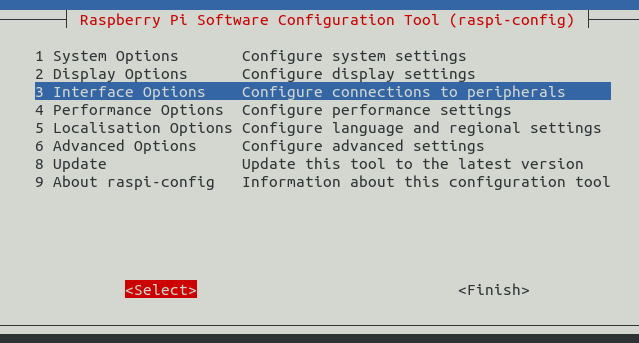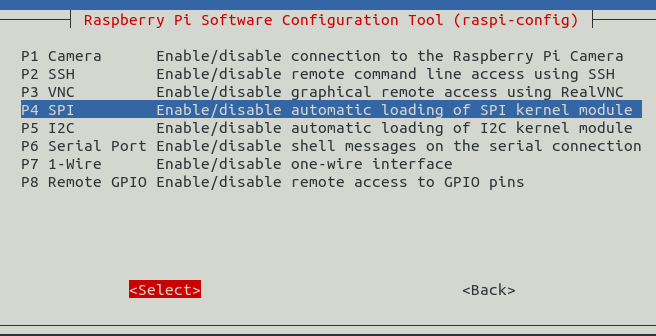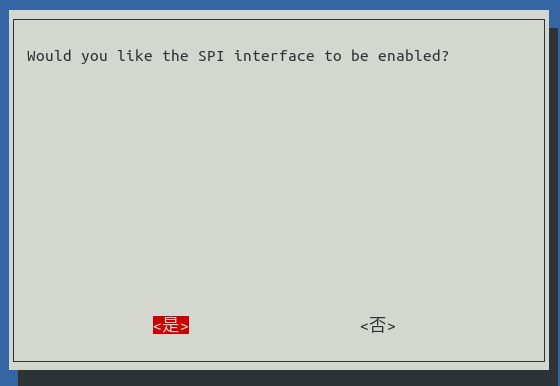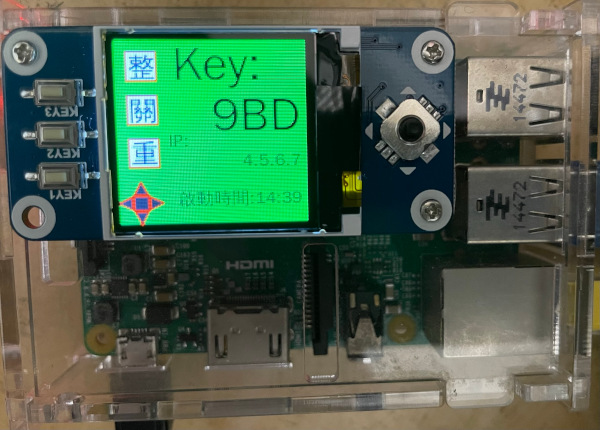在 Pi 或其他 Linux Distro 安裝設定 EPW 伺服器¶
考慮長期運作的高可用性,建議使用 Raspberry Pi + Linux OS 為 EPW 的伺服器。
EPW 是由 Django-based 程式碼及相關 Python3 函式庫所組成的應用程式,要在其他 x86, x86_64 硬體上執行也是可以運作的。作業系統使用 Linux-based OS 即可直接套用,目前實機使用過的 Linux Distro:
Ubuntu-20.04
Ubuntu-22.04
Raspberry Pi OS(32-bit) Version 10(buster)
Raspberry Pi OS(32-bit) Version 11(bullseye)
EPW 目前僅支援 USB 介面的 ESC/POS 印表機,詳細請參考 python-escpos 的支援清單,而有實機測試過的機型有:
TM-T82III
TM-T88IV
TM-T88V
TP805L
XP-Q90EC
ZJ-5890
只有 TM-T82III 、 TM-T88IV 、 TM-T88V 、 TP805L 可以列印符合規範的電子發票證明聯,而 TM-T88IV 只能設定 80mm 紙寬,要透過 EPW 處理後,方可列印電子發票證明聯於 57mm 紙捲上,但格式會被強制靠左。
Linux Distro 安裝注意事項¶
時區須設為 Asia/Taipei
ESC/POS 印表機設定¶
- 將執行 EPW 的用戶帳號加入到 lp, lpadmin 群組
$ sudo adduser <EPW_account> lp $ sudo adduser <EPW_account> lpadmin
- 自動讓 ESC/POS 印表機在插入 USB 後,權限分享至 lp 群組
# in /etc/udev/rules.d/50-usb_escpos_printer.rules # 04b8, 0202 是 Epson TM-T88IV 及 TM-T88V 的裝置參數,其他型請參照原廠文件 # 04b8, 0e28 是 Epson TM-T82III 的裝置參數,其他型請參照原廠文件 # 0483, 070b 是 Xprinter Q90EC 的裝置參數,其他型請參照原廠文件 # 0493, 8760 是 ZJiang ZJ-5890 的裝置參數,其他型請參照原廠文件 # 20d1, 7007 是 HPRT TP805L 的裝置參數,其他型請參照原廠文件 SUBSYSTEMS=="usb", ATTRS{idVendor}=="04b8", ATTRS{idProduct}=="0202", GROUP="lp", MODE="0666" SUBSYSTEMS=="usb", ATTRS{idVendor}=="04b8", ATTRS{idProduct}=="0e28", GROUP="lp", MODE="0666" SUBSYSTEMS=="usb", ATTRS{idVendor}=="0483", ATTRS{idProduct}=="070b", GROUP="lp", MODE="0666" SUBSYSTEMS=="usb", ATTRS{idVendor}=="0493", ATTRS{idProduct}=="8760", GROUP="lp", MODE="0666" SUBSYSTEMS=="usb", ATTRS{idVendor}=="20d1", ATTRS{idProduct}=="7007", GROUP="lp", MODE="0666"
- 重啟 udev 服務,以套用新 50-usb_escpos_printer.rules 設定:
sudo service udev restart
安裝基本函式庫¶
以 Python 3.X 為預設直譯器,本例使用 python3.9 :
$ sudo update-alternatives --install /usr/bin/python python $(readlink -f $(which python3.9)) 3 # set python3 as default
安裝工具程式、編譯程式、相依函式庫:
$ sudo apt install vim build-essential libssl-dev libffi-dev python3-dev cargo aptitude python3-virtualenv sqlite3 ttf-wqy-zenhei mlocate
更換比較方便使用的 shell(Optional):
$ sudo apt install zsh
安裝 zsh 後,設定請參照 zsh with oh-my-zsh: https://gist.github.com/aaabramov/0f1d963d788bf411c0629a6bcf20114d
驗證 ESC/POS 印表機功能¶
無須安裝任何原廠的 driver, tool, libary, …,有完整支援 ESC/POS 指令集的印表機,就可直接使用 python-escpos (pure python codes)操作。
安裝 python-escpos==3.0a8 :
$ virtualenv -p python3 TEST.py3env
$ source TEST.py3env/bin/activate
(TEST.py3env) $ pip install "python-escpos==3.0a8"
將 ESC/POS 印表機的 USB 線接入電腦,再執行 python shell 來測試,本例使用 HPRT TP805L:
(TEST.py3env) $ cat << 'EOF' > libs.py
import qrcode
from escpos.printer import Usb
from PIL import Image
class UsbWithBarcodeQRCodePair(Usb):
def barcode(self, code, bc, height=64, width=1, pos="OFF", font="A", align_ct=True, function_type='A', check=True):
from escpos.escpos import (six, BARCODE_TYPES, NUL,
BarcodeTypeError, BarcodeCodeError, BarcodeSizeError,
BARCODE_WIDTH, BARCODE_HEIGHT,
BARCODE_FONT_A, BARCODE_FONT_B,
TXT_STYLE,
BARCODE_TXT_OFF, BARCODE_TXT_BTH, BARCODE_TXT_ABV, BARCODE_TXT_BLW,)
bc_types = BARCODE_TYPES[function_type.upper()]
# Align Bar Code()
if align_ct:
self._raw(TXT_STYLE['align']['center'])
# Height
if 1 <= height <= 255:
self._raw(BARCODE_HEIGHT + six.int2byte(height))
else:
raise BarcodeSizeError("height = {height}".format(height=height))
# Width
if 1 <= width <= 6:
self._raw(BARCODE_WIDTH + six.int2byte(width))
else:
raise BarcodeSizeError("width = {width}".format(width=width))
# Font
if font.upper() == "B":
self._raw(BARCODE_FONT_B)
else: # DEFAULT FONT: A
self._raw(BARCODE_FONT_A)
# Position
if pos.upper() == "OFF":
self._raw(BARCODE_TXT_OFF)
elif pos.upper() == "BOTH":
self._raw(BARCODE_TXT_BTH)
elif pos.upper() == "ABOVE":
self._raw(BARCODE_TXT_ABV)
else: # DEFAULT POSITION: BELOW
self._raw(BARCODE_TXT_BLW)
self._raw(bc_types[bc.upper()])
if function_type.upper() == "B":
self._raw(six.int2byte(len(code)))
# Print Code
if code:
self._raw(code.encode())
else:
raise BarcodeCodeError()
if function_type.upper() == "A":
self._raw(NUL)
def qrcode_pair(self, line):
images = []
for s in [line['qr1_str'], line['qr2_str']]:
qr = qrcode.QRCode(version=1,
error_correction=qrcode.constants.ERROR_CORRECT_L,
box_size=5,
border=0)
qr.add_data(s)
qr.make(fit=True)
img = qr.make_image(fill_color="black", back_color="white")
img = img.resize((154, 154))
images.append(img)
qr_image = Image.new("RGB", (347, 180), color='white')
qr_image.paste(images[0], (13, 13))
qr_image.paste(images[1], (193, 13))
self.image(qr_image)
EOF
(TEST.py3env) $ python3
Python 3.10.6 (main, Mar 10 2023, 10:55:28) [GCC 11.3.0] on linux
Type "help", "copyright", "credits" or "license" for more information.
>>>
from libs import UsbWithBarcodeQRCodePair
import re, usb.core, usb.util
devs = {}
for dev in usb.core.find(find_all=True):
try:
iProduct = usb.util.get_string(dev, dev.iProduct)
except:
continue
if iProduct and iProduct.strip() in ["TM-T82III",
"TM-T88V",
"TM-T88IV",
"TP805L",
"USB Printing Support",
"POS58 Printer USB",
]:
devs[iProduct.strip()] = dev
product = "TP805L"
x, y = devs[product][0].interfaces()[0].endpoints()
if re.search('bEndpointAddress .* IN', str(x)):
in_ep = x.bEndpointAddress
out_ep = y.bEndpointAddress
else:
out_ep = x.bEndpointAddress
in_ep = y.bEndpointAddress
pd = UsbWithBarcodeQRCodePair(devs[product].idVendor, devs[product].idProduct, in_ep=in_ep, out_ep=out_ep,
usb_args={"address": devs[product].address, "bus": devs[product].bus},
profile='default')
pd.set(align='left')
if "printer supports CP950":
#INFO: 印表機使用 Big5 字集
pd.charcode(code='CP1252')
pd.textln('電子發票證明聯\n測試補印\n年月隨機碼總計\n列印序號\n賣方\n買方\n9876543210\n\n'.encode('cp950').decode('latin1'))
elif "printer supports GB18030":
#INFO: 印表機使用 GB18030 字集
pd.charcode(code='ISO_8859-2')
pd.textln('電子發票證明聯\n測試補印\n年月隨機碼總計\n列印序號\n賣方\n買方\n9876543210\n\n'.encode('gb18030').decode('latin2'))
pd.barcode('99912HO987654321111', 'CODE39')
pd.qrcode_pair({"qr1_str": "FN350996001111031458100000258000002580000000024634102jbdmlVBHXApivmgZzzzzzz==:e378123456:1:1:1:", "qr2_str": "**何六百文件:1:600"})
pd.cut()
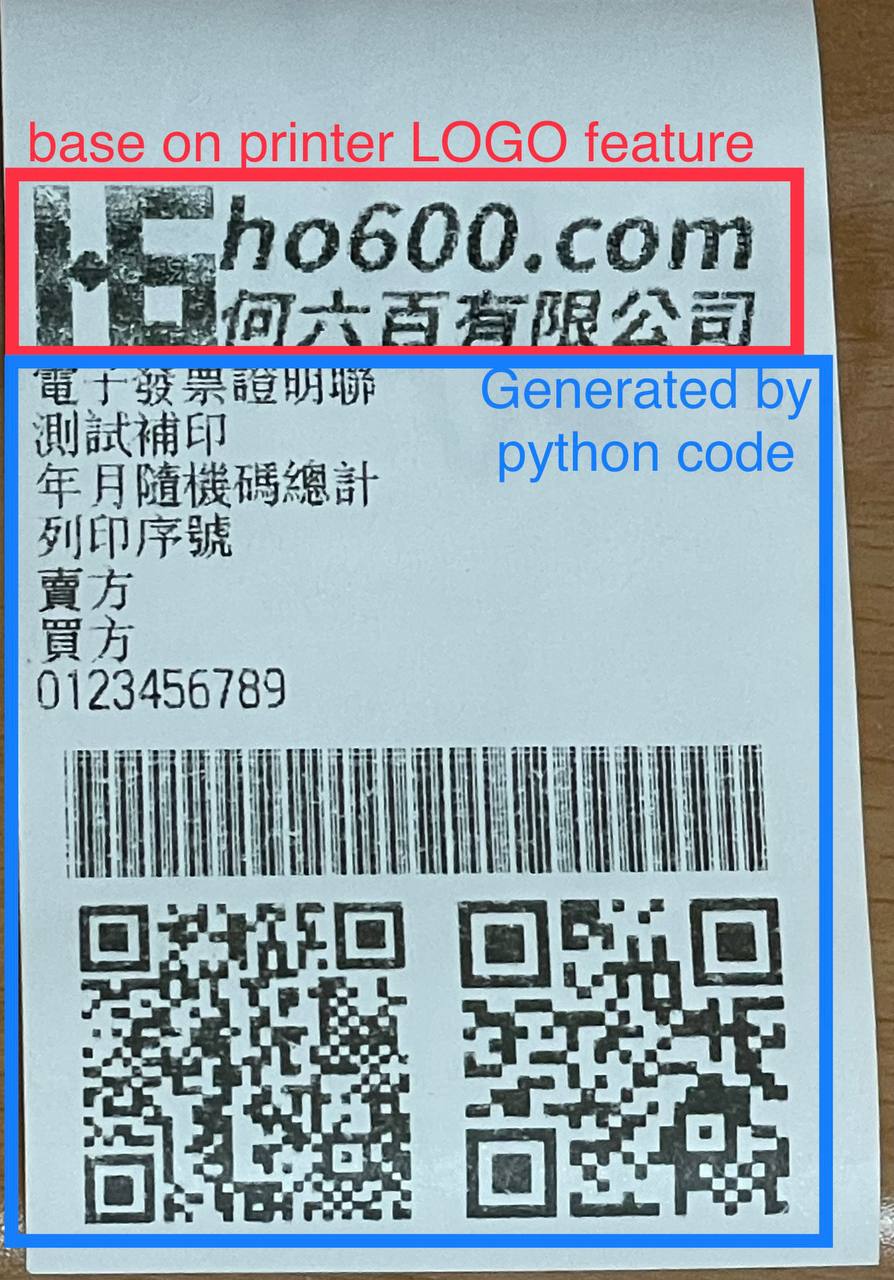
列印成果¶
設定 EPW 基本服務¶
服務有:
列印發票/收據
檢查感熱式印表機狀態
$ git clone git@github.com:ho600-ltd/Django-taiwan-einvoice.git
$ virtualenv -p python3 Django-taiwan-einvoice.py3env
$ source Django-taiwan-einvoice.py3env/bin/activate
$ pip install -r Django-taiwan-einvoice/escpos_web/requirements.txt
$ cp -rf Django-taiwan-einvoice/escpos_web/capabilities.json Django-taiwan-einvoice.py3env/lib/python3.9/site-packages/escpos/
$ pip install ipython
$ cd Django-taiwan-einvoice/escpos_web/
$ ./manage.py migrate
$ ./manage.py shell # create "te_web object". The url, slug, hash_key should be getting from TEA service; update "Printer object"
$ cp -rf Django-taiwan-einvoice/escpos_web/check_printer_status.conf Django-taiwan-einvoice/escpos_web/print_receipt.conf /etc/supervisor/conf.d/ # then update some settings
$ sudo apt install supervisor
$ sudo systemctl enable supervisor
$ sudo supervisorctl reread
$ sudo supervisorctl update
TEA 以 WebSocket 連線 EPW 時的驗證碼¶
在 TEA 上設定預設發票機時,必須填寫驗證碼,此驗證碼是登記在 EPW 的 /var/run/boot_random_seed 檔案。
要讓 EPW 在每次開機時,隨機產製出驗證碼供 TEA 驗證用,可透過 /etc/rc.local:
$ sudo su -
$ cat << 'EOF' > /etc/rc.local
#!/bin/sh -e
date "+%Y%m%d%H%M%S.%N Whatever words" | md5sum > /var/run/boot_random_seed
exit 0
EOF
$ exit
$ chmod a+x /etc/rc.local
生成 /var/run/boot_random_seed 後,可在 Waveshare LCD 來觀看驗證碼,但若未使用 Waveshare LCD ,則建議寫入固定值到 /var/run/boot_random_seed ,如:
echo "31a36a1b579fc1f1349183390d5b0a46 -" > /var/run/boot_random_seed
這樣驗證碼會保持在 31A ,在 TEA 上就是固定填寫 31A 驗證碼。
設定 EPW Portal(非必要)¶
若發票機上設定的 TEAWeb 紀錄超過 1 個時,就可以使用 Portal 服務來調整現時要連線的是那一個 tea_web 。當然也可以直接 ssh 連入發票機中,使用 django shell 手動設定某個 tea_web.now_use = True 。
設定 Portal 步驟:
$ virtualenv -p python3 Django-taiwan-einvoice.py3env
$ source Django-taiwan-einvoice.py3env/bin/activate
$ pip install -r Django-taiwan-einvoice/escpos_web/requirements.txt
$ pip install ipython
$ cd Django-taiwan-einvoice/escpos_web/
$ ./manage.py migrate
$ ./manage.py createsuperuser
Username (leave blank to use 'XXX'):
Email address: XXX@ho600.com
Password:
Password (again):
Superuser created successfully.
$ cp -rf Django-taiwan-einvoice/escpos_web/epw.conf /etc/supervisor/conf.d/ # then update some settings
$ sudo supervisorctl reread
$ sudo supervisorctl update
EPW Portal 預設是使用 8443 port,主要是 pi user 權限無法設定在 443 上,如希望以 https://xxx.yyy.zzz/ 而不是 https://xxx.yyy.zzz:8443/ 來瀏覽 Portal 網站,則再利用 iptables 作轉埠:
$ sudo apt-get install iptables-persistent
$ sudo iptables -A PREROUTING -t nat -p tcp --dport 443 -j REDIRECT --to-port 8443
$ sudo sh -c "iptables-save > /etc/iptables/rules.v4"
假使 EPW 拿到的內部 IP 是 192.168.7.88 ,則使用與 EPW 同一區網的電腦,在其瀏覽器上瀏覽 https://192.168.7.88/ ,輸入 superuser 帳密,再進入「臺灣電子發票管理網站」頁面:
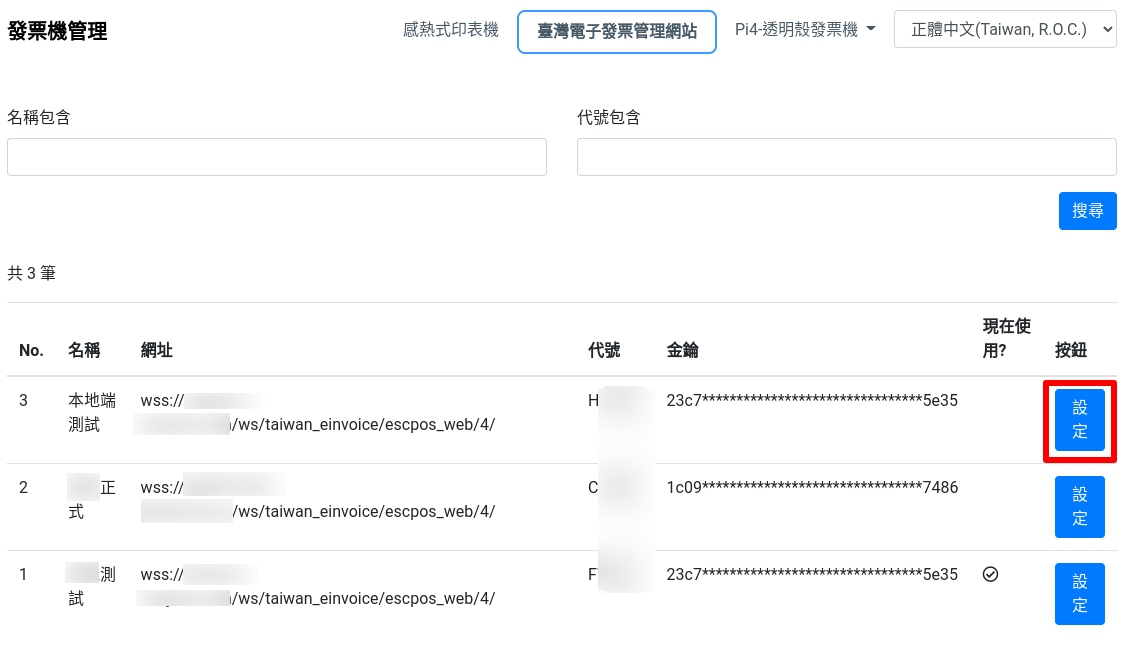
顯示連線網站列表¶
點擊「設定」按鈕後,跳出視窗:
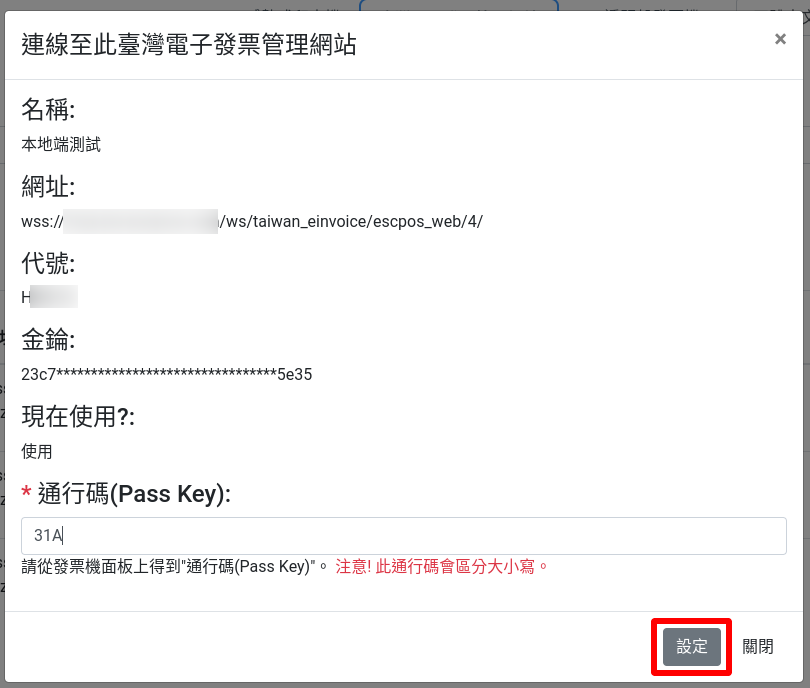
選擇要更改連線的網站,點擊「設定」按鈕¶
輸入「驗證碼」後按下「設定」即可更新「所連線的臺灣電子發票管理系統」。
